
Packington Hall is a 17th-century mansion situated at Great Packington, near Meriden in Warwickshire, England and is the seat of the Earl of Aylesford. It is a Grade II listed building.

Packington Hall is a 17th-century mansion situated at Great Packington, near Meriden in Warwickshire, England and is the seat of the Earl of Aylesford. It is a Grade II listed building.

Packington Hall was built in 1693 for Sir Clement Fisher [2] on whose death in 1729 the Packington estate passed to his daughter Mary Fisher, who married Heneage Finch, 2nd Earl of Aylesford.

The Park was designed by Capability Brown [4] in 1751, who created a large serpentine lake called Hall Pool by joining up several old mill and fish ponds in front of the Hall. [5]
The Hall was remodelled for the 3rd Earl of Aylesford by Matthew Brettingham from 1766, [6] with the work continuing after Brettingham's death in 1769 under Henry Couchman. It was then extended and improved for the 4th Earl of Aylesford in Palladian style to designs by Italian architect Joseph Bonomi [7] in 1772. The ceiling paintings were by John Francis Rigaud. [8]
Stables were added to the Hall in the 1760s by the 3rd Earl of Aylesford, constructed by David Hiorne, to house horses and carriages. [9] In 1787, the carriage turn outside the east of the Hall was levelled under the supervision of John Wedge. [10] The Stables are Grade II listed buildings.
It was severely damaged by fire in 1979 [11] [12] but has since been fully restored. The renovations were kept as near as possible to the original design.
The main entrance to the grounds from the A45 road features a pair of wrought-iron gates [10] which were presented to the Earl of Aylesford by his tenants in 1935.
The house is not generally open to the public but is available by arrangement for conferences and functions.
An earlier manor house (Packington Old Hall) and an 18th-century parish church St James' Church, Great Packington stand on the estate. [1]

Lancelot "Capability" Brown was an English gardener and landscape architect, a notable figure in the history of the English landscape garden style.

Earl of Aylesford, in the County of Kent, is a title in the Peerage of Great Britain. The junior branch of the Earl of Winchilsea and Nottingham. It was created in 1714 for the lawyer and politician Heneage Finch, 1st Baron Guernsey. He had already been created Baron Guernsey in the Peerage of England in 1703.

Joseph Bonomi the Elder was an Italian architect and draughtsman who spent most of his career in England where he became a successful designer of country houses. Bonomi was Robert Adam’s leading draughtsman.

Weston Park is a country house in Weston-under-Lizard, Staffordshire, England, set in more than 1,000 acres (400 ha) of park landscaped by Capability Brown. The park is located 10 miles (16 km) north-west of Wolverhampton, and 8 miles (13 km) east of Telford, close to the border with Shropshire. The 17th-century Hall is a Grade I listed building and several other features of the estate, such as the Orangery and the Stable block, are separately listed as Grade II.
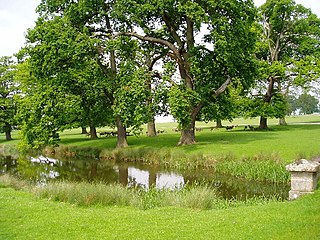
Great Packington, historically known as Packington Magna, is a hamlet, civil parish and country park in the North Warwickshire district of Warwickshire, England. The parish of Meriden is to the south-east, and Little Packington to the west. At Great Packington is Packington estate, which includes Packington Hall, Packington Old Hall and the Greek revival style St James' Church.
Little Packington is a hamlet and civil parish in the North Warwickshire district of the county of Warwickshire, England, and is sometimes known by the names Packington Piggott or Packington Parva. The hamlet is situated just to the northwest of Great Packington, close to the boundaries of Packington Park and sits on the River Blythe.

Nether Whitacre is a small village and larger rural civil parish in North Warwickshire, Warwickshire, England.
Henry Couchman was an English architect and landscape gardener. He designed the Old Drapers' Hall, Coventry and the House of Correction in Warwick. He helped complete Arbury Hall, Warwickshire, for Sir Roger Newdigate, including designing the magnificent saloon.

Offchurch Bury is a manor house one mile north-west of the centre of the village of Offchurch, Warwickshire, England. It is supposed to represent the site of a palace of the Anglo-Saxon King Offa of Mercia (d.796), after which Offchurch is named, "bury" being a corruption of "burh" meaning a fortified place. William Dugdale in his Antiquities of Warwickshire (1656) stated concerning the manor of Offchurch:

Matthew Brettingham, sometimes called Matthew Brettingham the Elder, was an 18th-century Englishman who rose from modest origins to supervise the construction of Holkham Hall, and become one of the best-known architects of his generation. Much of his principal work has since been demolished, particularly his work in London, where he revolutionised the design of the grand townhouse. As a result, he is often overlooked today, remembered principally for his Palladian remodelling of numerous country houses, many of them situated in the East Anglia area of Britain. As Brettingham neared the pinnacle of his career, Palladianism began to fall out of fashion and neoclassicism was introduced, championed by the young Robert Adam.
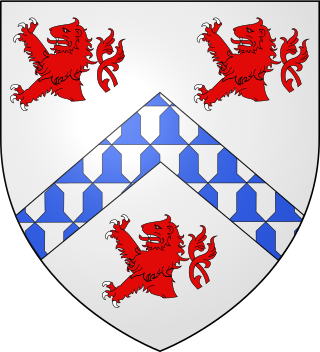
There have been two baronetcies created for persons with the surname Fisher, both in the Baronetage of England.
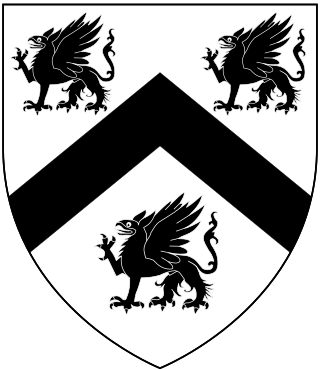
Heneage Finch, 4th Earl of Aylesford, PC, FRS, FSA, styled Lord Guernsey between 1757 and 1777, was a British politician who sat in the House of Commons from 1772 to 1777 when he succeeded to a peerage. He was also a landscape artist.
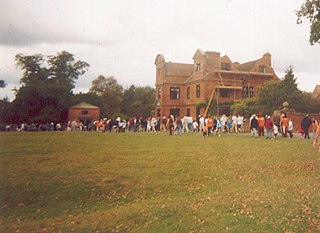
Packington Old Hall is a 17th-century manor house situated at Great Packington, near Meriden, Warwickshire. It is a Grade II listed building. It stands in gardens enclosed by late 17th century brick walls.

St James' Church is an 18th-century chapel situated in the grounds of Packington Hall, near Meriden, Warwickshire. It is a Grade I listed building.

Heneage Finch, 6th Earl of Aylesford DL, styled Lord Guernsey until 1859, was a British peer and politician.

Heneage Finch, 2nd Earl of Aylesford, styled Lord Guernsey from 1714 to 1719, was an English politician, courtier and peer who sat in the English and British House of Commons from 1704 to 1719, representing the constituencies of Maidstone and Surrey. Born in Albury, Surrey into an aristocratic family, he also served as the Master of the Jewel Office from 1711 to 1716.

Heneage Finch, 3rd Earl of Aylesford, styled Lord Guernsey between 1719 and 1757, was a British peer and politician.

Shire Hall is a building complex located in Northgate Street in Warwick, England. It is the main office and the meeting place of Warwickshire County Council. It comprises both the original Shire Hall of 1758 and the more recent adjoining county council offices, both of which are Grade I listed buildings.
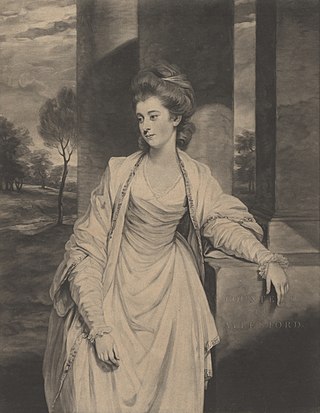
Louisa Finch, Countess of Aylesford was an English naturalist and botanical illustrator who made studies and paintings of the plants, algae, and fungi from the Warwickshire area.

Heneage Finch, 7th Earl of Aylesford, styled The Honourable from birth until 1859, then Lord Guernsey until 1871, and also known as Joseph Heneage Finch, was a British aristocrat and friend of the Prince of Wales. Finch enjoyed many outdoor pursuits, and in his social circle was nicknamed "Sporting Joe."